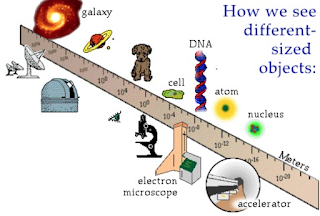 |
| Big Doll = Atom with Nucleus = Small Doll . |
RealQM presents a new Schrödinger equation for atomic physics as a positive nucleus of size $10^{-15}$ m surrounded by a collection of non-overlapping electrons densities without self-repulsion of size $10^{-10}$ m, which in ground/excited states organise into shells as solution to an energy minimisation packing problem under Coulomb attraction/repulsion.
RealQM is a classical continuum model in 3 spatial dimensions describing deterministic physics, fundamentally different from standardQM in multidimensional configuration space with unclear physics as statistics.
Similarly RealQM presents a Schrödinger equation for an atomic nucleus of size $10^{-15}$ m as a negative kernel of size $10^{-20}$ m surrounded by a collection of non-overlapping proton densities without self-repulsion of size $10^{-15}$ m organizing into shells under Coulomb attraction/repulsion.
The change of spatial scale between atom and atomic nucleus of $10^5$ is translated to binding energies with the same factor.
The basic case is represented by two possible configurations of 1 proton and 1 electron: As a H atom with proton kernel surrounded by an electron density with binding energy 13.6. eV, and as a neutron N as an electron kernel surrounded by a proton density with binding energy 0.78 MeV with a factor of about $10^5$.
What emerges is a form of Russian Doll with an H atom as a Big Doll with nucleus as a Small Doll composed in the same way with just a switch of sign of charge. It is possible to think of even bigger dolls built in a similar way such as planet systems around a star.
In RealQM an atomic nucleus is held together by Coulomb attraction between electron kernel and surrounding proton density thus overpowering proton repulsion, in the same way an atomic ion is held together by Coulomb attraction between proton nucleus and surrounding electron density overpowering electron repulsion. There is here no need to ad hoc introduce a strong force as in the Standard Model.
The configuration can in principle be repeated with an even smaller doll with positive kernel of even smaller size of $10^{-25}$ m. But that is beyond observation and so it seems reasonable to search for an explanation why there are so to speak only two atomic dolls: Atom = Big Doll and atomic nucleus = Small Doll.
That requires that the kernel of an atomic nucleus as a negative charge of strength more than 1 is free of self-repulsion, since it has no positive kernel overpowering repulsion as in Big and Small Doll. This remains to be understood. Can two electrons be compressed to a negative charge density -2 without self-repulsion? Is this possible by some form of quantum gravity? In any case this makes two electrons fundamentally different from two protons for which there is no need of compression to +2 without self-repulsion.
A Russian Doll system as a form of fractal system describing the Universe as a repeating pattern, would thus end with a Small Doll in the form of a nucleus as a negative charge density of size $10^{-20}$ m without self-repulsion surrounded by a collection of non-overlapping proton densities organised into shells as solution to an energy minimisation packing problem. Such a nucleus would be held together by Coulomb attraction overpowering repulsion without need of the strong force of the Standard Model.
Recall that the early Bohr model of an atom was a planetary system of electrons/planets orbiting a nucleus/Sun. In RealQM this is replaced by a stationary system of non-overlapping electron densities surrounding a nucleus as solution to an energy minimisation packing problem. Compare with Fractal Cosmology. It seems that we can find fractals on largest scales governed by gravitational attraction and smallest scales governed by Coulomb electric attraction, but not on human scales showing more complexity.
Note that it would be sensational if nuclei show to be held together by Coulomb attraction as classic physics, rather than by a residual of a strong force between quarks as postulated in the Standard Model.
PS1 When I ask professional physicists if in the existing literature there is something like RealQM, they do not give any answer, but tell me that standard Quantum Mechanics, whatever that is, and the Standard Model are by far the best theories about physics ever created and that they agree with all experiments to an incredible precision and so there is no reason to look at anything else, in particular nothing from a mathematician. In the next moment they tell that in fact both models have severe shortcomings, which motivate more tax payer money to new fundamental theoretical physics to be discovered by a new much bigger Large Hadron Collider.
PS2 From A Search for Exotic Higgs Decays by Burzynski: In spite of the overwhelming successes of the SM, there are several glaring issues with the SM which remain unresolved. First and foremost, there are many fundamental phenomena observed in nature that are not predicted or explained by the SM. These include gravity, the nature of dark matter, neutrino masses, and the matter-antimatter asymmetry observed in the universe, among others. Second, there are theoretical problems with the SM which imply a lack of complete understanding of underlying phenomena. Examples include the hierarchy problem and the strong CP problem.













